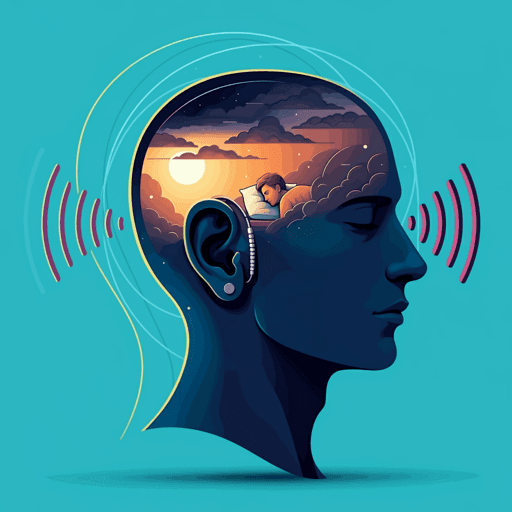
Medicine and Health
Exploring the interplay of depression, sleep quality, and hearing in tinnitus-related handicap: insights from polysomnography and pure-tone audiometry
T. Chang, Y. Yao, et al.
Discover a clinical study using polysomnography and pure-tone audiometry to explore links between tinnitus, hearing, sleep quality, and depression in 100 outpatients. The authors—Ting-Gang Chang, Yi-Ting Yao, Chiann-Yi Hsu, and Ting-Ting Yen—report high rates of depression and obstructive sleep apnea among tinnitus patients and a strong correlation between tinnitus handicap and depressive symptoms.
~3 min • Beginner • English
Introduction
This study examines whether tinnitus is associated with severe depression, poor sleep quality, impaired hearing, and sleep-related breathing problems, reflecting the complex interplay among auditory, emotional, and sleep systems. Prior work shows elevated rates of depression among tinnitus patients and inconsistent objective sleep findings. The authors aimed to clarify these relationships by using both objective (polysomnography and pure-tone audiometry) and subjective measures (PHQ-9, PSQI, THI-CM) in a diverse outpatient sample from otolaryngology and psychiatry clinics. The hypothesis was that tinnitus would be associated with more severe depression, poorer sleep quality, worse hearing thresholds, and greater sleep-disordered breathing.
Literature Review
Background literature indicates: (1) Depression is prevalent among tinnitus patients (about one-third in reviews), with tinnitus severity correlating with depressive symptoms. (2) Polysomnography studies report mixed findings: some show no objective sleep differences despite poorer subjective sleep, while others find reduced deep sleep and REM sleep in tinnitus; severe sleep apnea has been linked to higher tinnitus prevalence. (3) Bruxism and temporomandibular disorders may exacerbate tinnitus, while periodic limb movement syndrome severity may not differ by tinnitus status. (4) Poor sleep quality prior to tinnitus onset might increase tinnitus risk. (5) Hearing and stress: PTA is essential to quantify hearing thresholds; chronic stress can lead to hearing loss and increase tinnitus risk, potentially via inner ear HPA-like mechanisms. (6) Prior systematic reviews highlight selection bias and lack of objective hearing tests in many studies. These gaps motivate objective assessment of sleep and hearing, alongside validated scales for sleep quality and depression, to disentangle their relationships with tinnitus-related handicap.
Methodology
Design and setting: Cross-sectional study conducted from January 2021 to July 2022 at Taichung Veterans General Hospital, Taiwan. Participants were recruited from outpatient psychiatry and otolaryngology clinics and divided into tinnitus and non-tinnitus groups per inclusion/exclusion criteria.
Participants: 100 outpatients (65 tinnitus; 35 controls). Inclusion criteria: age >20 years; chronic subjective tinnitus >3 months (tinnitus group); willingness to complete tests/questionnaires. Exclusion criteria: sudden hearing loss, Meniere’s disease, organic brain disorders (e.g., acoustic neuroma, stroke), severe mental illness (e.g., schizophrenia, bipolar disorder, major depressive disorder). Controls denied tinnitus or hearing issues upon physician inquiry.
Data collected: demographics (age, sex), anthropometrics (BMI, neck and waist circumference), full-night polysomnography (PSG) for all participants, rating scales (PHQ-9, PSQI [Chinese version]) for all; THI-CM and pure-tone audiometry (PTA) for the tinnitus group.
Polysomnography: Standard overnight diagnostic PSG (Compumedics E-series). Channels included EEG (C3/A2, C4/A1, O1/A2, O2/A1), EOG, submental and tibial EMG, ECG, oronasal airflow (thermocouple), thoracic/abdominal belts (inductive plethysmography), oximetry, and snoring microphone. Derived indices: arousal index (events/hour), snore index (snores/hour), apnea index (apneas/hour), AHI (apnea+hypopnea events/hour). OSAS severity categorized as mild (5–14), moderate (15–30), severe (>30 events/hour).
Pure-tone audiometry: Pure-tone air and bone conduction thresholds at 250–8000 Hz using Grason Stadler (Otometrics, USA). Pure-tone average (PTA) calculated at 500, 1000, 2000, 4000 Hz. Hearing level in dB HL. Hearing loss categories per ASHA: normal (−10 to 15 dB HL), slight (16–25), mild (26–40), moderate (41–55), moderately severe (56–70), severe (71–90), profound (≥91).
Questionnaires: PHQ-9 (depression severity; total 0–27; standard cutoffs; validated sensitivity/specificity ~88%). PSQI (sleep quality over past month; total 0–21; >5 suggests sleep pathology). THI-CM (25 items; functional, emotional, catastrophic subscales; grades 1–5 reflecting increasing handicap severity).
Statistical analysis: Descriptive statistics for all variables. Group comparisons via Chi-square, Fisher’s exact, Mann–Whitney, Kruskal–Wallis with Dunn–Bonferroni post hoc. Spearman correlations examined associations between THI-CM and continuous variables (PSQI, PHQ-9, PSG metrics, PTA, BMI, neck/waist). ROC analyses to predict depression (PHQ-9≥10) in the tinnitus group using PSQI and THI-CM. Logistic regression assessed factors associated with tinnitus (univariate and multivariate) and factors associated with depression (PHQ-9≥10). Multinomial logistic regression examined associations of categorical THI-CM grades (1, 2, 3–5) with predictors, with additional models adjusted for obstructive sleep apnea. Significance threshold p<0.05. Analyses performed in SPSS v22.
Key Findings
- Sample: 100 participants (65 tinnitus; 35 controls); 60% male; mean age 53.9±12.8 years; BMI 25.60±4.02 kg/m². Overall, 63% had PHQ-9≥10 and 66% had AHI>5.
- Group differences: Tinnitus group had higher proportion male (67.69% vs 45.71%, p=0.032) and higher proportion with AHI>5 (73.85% vs 51.43%, p=0.024). No significant differences in PSQI total, PHQ-9 total, REM %, stage N3 %, leg movement index, or other PSG parameters between groups.
- Within tinnitus group (n=65): THI-CM mean 21.84±24.04; grade distribution: G1 26.15%, G2 35.38%, G3 21.54%, G4 13.85%, G5 3.08%. Hearing loss prevalence by AC PTA: right ear 53.85% (mean 21.77±17.68 dB HL), left ear 64.62% (mean 23.40±17.02 dB HL); by BC PTA: right ear 43.08% (19.92±17.88 dB HL), left ear 50.77% (21.05±18.39 dB HL).
- Logistic regression for tinnitus (vs controls): Univariate associations: AHI>5 (OR 2.67, 95% CI 1.12–6.32, p=0.026), male sex (OR 2.49, 95% CI 1.07–5.79, p=0.034). Multivariate: not significant (male OR 1.94, p=0.150; AHI>5 OR 2.12, p=0.111).
- Correlations (tinnitus group): THI-CM correlated with PSQI total (r=0.44, p<0.001), subjective sleep quality (r=0.47, p<0.001), daytime dysfunction (r=0.43, p<0.001), sleep disturbances (r=0.39, p<0.001), and PHQ-9 total (r=0.50, p<0.001). No correlation with hearing thresholds, AHI, minimum SpO2, neck or waist circumference.
- THI-CM grade comparisons: PHQ-9 increased with THI severity (G1 4.76±4.25; G2 5.65±4.02; G3–5 9.84±3.83; p<0.001). Depression (PHQ-9≥10): G1 41.18%, G2 47.83%, G3–5 92.00% (p=0.001). PSQI total also increased (G1 7.24±3.75; G2 10.33±3.92; G3–5 12.72±4.30; p=0.001). Select PSQI subscales (subjective sleep quality, sleep disturbances, use of sleep medication, daytime dysfunction) differed by THI grade.
- Multinomial logistic regression: Univariate: PHQ-9 total (OR 1.37, 95% CI 1.13–1.66, p=0.001), depression (PHQ-9≥10) (OR 16.43, 95% CI 2.89–93.41, p=0.002), and obstructive sleep apnea were associated with THI-CM Grade 3–5 vs Grade 1. After adjustment for obstructive sleep apnea: PHQ-9 total (OR 1.28, 95% CI 1.04–1.56, p=0.017) and depression (OR 8.68, 95% CI 1.19–63.32, p=0.033) remained associated with Grade 3–5 vs Grade 1.
- ROC for depression prediction (tinnitus group): PSQI>13 and THI-CM>47 yielded AUC >0.73 and >0.75, respectively (supplementary).
- Factors associated with depression (PHQ-9≥10) in regression: PSQI>13 (multivariate OR 7.06, 95% CI 1.37–36.50, p=0.020) and THI-CM>47 (multivariate OR 7.43, 95% CI 1.73–32.02, p=0.007).
Discussion
The study investigated how tinnitus and tinnitus-related handicap relate to objective sleep architecture, hearing thresholds, subjective sleep quality, and depression. Despite previous reports of reduced REM and deep sleep in tinnitus, this cohort—primarily with slight to mild hearing loss and mild tinnitus handicap—showed no significant differences in PSG parameters between tinnitus and non-tinnitus groups. The lack of PSG differences may reflect the mild tinnitus severity and the use of a control group with sleep complaints. In contrast, tinnitus-related handicap was moderately associated with depressive symptom severity and poorer subjective sleep quality, while not correlating with objective hearing thresholds or PSG-derived indices (e.g., AHI, minimum SpO2). Univariate analyses suggested higher odds of tinnitus with AHI>5 and male sex, but these associations attenuated after adjustment, aligning with mixed literature on OSA-tinnitus links. Clinically, depression appears to be a key determinant of tinnitus handicap, and high PSQI (>13) or THI-CM (>47) scores may help identify individuals at risk for depression. Given the high prevalence of OSA among tinnitus patients, routine assessment for sleep-disordered breathing remains relevant, although its direct link to tinnitus severity was not supported here. The findings support prioritizing depression screening and management within multidisciplinary tinnitus care.
Conclusion
Among adults largely characterized by slight/mild hearing loss and mild tinnitus handicap, depression and poor subjective sleep quality correlated with higher tinnitus-related handicap, with depression emerging as the primary factor. Objective PSG parameters and hearing thresholds were not associated with tinnitus handicap in this sample. Clinicians should consider screening for depression and OSA in tinnitus patients; PSQI>13 and THI-CM>47 may warrant psychiatric referral for depression evaluation. Future research should use larger samples, longitudinal designs, repeated/home sleep testing, and neuroimaging/functional assessments to clarify mechanistic links among tinnitus, sleep, and depression.
Limitations
- Medical center-based sample likely enriched for comorbidities (e.g., sleep-disordered breathing), limiting generalizability.
- Group size imbalance (65 tinnitus vs 35 controls) due to recruitment constraints; may reduce power to detect between-group differences.
- Single-night in-hospital PSG may be influenced by first-night effects and participants’ emotional state (high depression prevalence), potentially affecting sleep metrics.
- Heterogeneity in comorbidities and ongoing treatments (e.g., sedative-hypnotics potentially worsening OSA; antidepressants affecting sleep/mood) not fully controlled.
- Diagnostic classifications for sleep disorders and depression could be further refined; reliance on PHQ-9 cutoff for depression.
- Control group did not undergo PTA, risking undetected hearing impairments.
- Cross-sectional design precludes causal inference.
Related Publications
Explore these studies to deepen your understanding of the subject.







